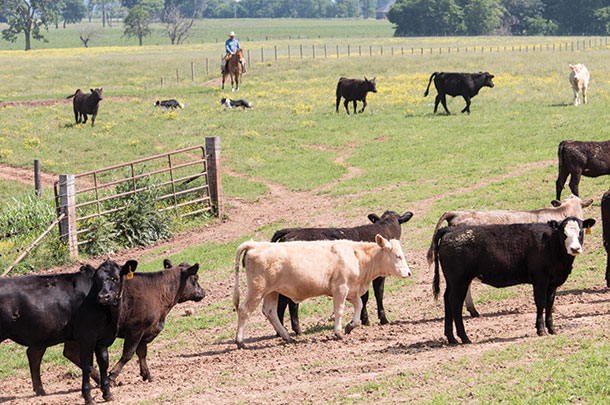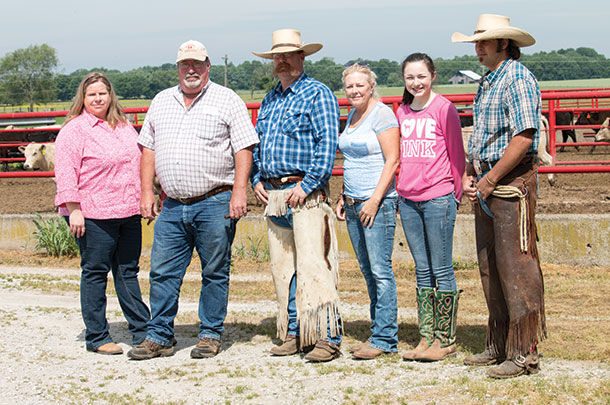At the betting window, only a win bet was offered, and wagers on Secretariat lost $0.10 on the dollar. Onion’s bets were paid at $13.20 on the dollar.
Famous as he was, Secretariat was not a sure bet. There are no sure bets; that’s why it’s wise to hedge – to balance the wager, reduce the risk.
Heritage Livestock, a feeder-stocker operation near Bowling Green, Kentucky, hedges its bets on raising healthy cattle for profit with improved cattle handling and BVD-PI testing.
Jason Wallace is in charge of animal health at Heritage Livestock and is very conscious of the stress the cattle are under as they are received at the facilities. As one method to mitigate the stress, he trains border collie stock dogs to slip around the calves quietly and in a very controlled, consistent pattern to slow the calves’ natural tendency to spook and run.

Wallace says that although they’re constantly training new groups of cattle, “Handling cattle doesn’t have to look like a rodeo.” The dogs work quietly, stealthily and effectively to move cattle from pastures to bunks and acclimate them to the new surroundings.
Wallace and two or three of his dogs can move 100 or more young animals from a large pasture through a narrow corral gate without assistance, without yelling, without cattle bawling and without quick movement. It all results in quieter, less-stressed animals. Wallace and his dogs easily achieve what it might take four other cowboys to accomplish.
To maintain healthy animals, Wallace also says BVD-PI testing is critical, especially when an operation like Heritage Livestock brings in so many head of new cattle every week. “It’s a simple process: rinse [the ear notcher], disinfect, rinse, punch ear and repeat,” Wallace says.
The lab supplies all the vials and materials, and cost of the test is $3.50 per head with results generally available the same day. An animal has only to be tested once per lifetime, as it’s either born positive PI or negative PI.
Bovine viral diarrhea (BVD) is the number one cause of respiratory disease in confined cattle, and exposed cattle are picking it up from animals that can look totally normal. These normal-looking carriers are persistently infected (PI) and were born that way, as BVD crosses the placental wall from an exposed mother to the fetus during gestation, creating a PI calf.
PI calves look like any other calf, but the difference is they will shed 1 million to 10 million virus particles daily throughout their lives. Healthy animals can pick up the virus by sharing fencelines, water tanks and bunks. The only way to know whether a calf is a carrier of the virus (or PI) is to test for it by taking an ear-notch sample and conducting lab analysis.
Research shows simply exposing pens of feedlot cattle to a BVD-PI animal makes them 43 percent more likely to need treatment for bovine respiratory disease (BRD) and results in performance losses averaging $88.26 per head (using 2012 figures).
A PI animal can infect its herdmates, often overwhelming the immune systems of vaccinated cattle. While vaccinating cattle for BVD helps manage it, the vaccination cannot be relied upon to keep a herd free of PI cattle. 
As a stocker-grower who processes more than 10,000 head of livestock a year, Brian Grant, owner of Heritage Livestock, doesn’t want to bet on whether or not a load of cattle might have a BVD-PI carrier. So they ear-notch every animal as it comes off the truck. Brian buys mostly 425- to 475-pound calves, keeps them 60 to 90 days and sells them to feedlots in the Midwest.
PI testing is relatively simple. As cattle are processed with vaccinations, branding and worming procedures, a notch of hide is taken from one ear. This is placed in a sterile plastic vial and sent to a lab. Heritage Livestock uses Gold Standard Labs, which is located a few miles down the road in Bowling Green.
Sandy Grant, lab manager at Gold Standard Labs, says one-third of PI animals will die before they reach 500 pounds, one-third will finish without issue or showing symptoms, and one-third can be “sudden pen-deads.” If an animal tests positive as PI, the animal can be finished in isolation and harvested.
Positive PI animals need biosecurity of a 30-foot boundary between them and other cattle to reduce infecting other animals. There is no vaccine or cure for a PI animal. To prevent producing a PI animal, cows should be vaccinated 30 days prior to breeding.
Sandy says, “Four head per thousand test positive for PI, and obviously the prevalence is higher for younger animals. Some ranchers like to test newborns during calving season and wait to collect several samples before sending them in."
"It’s better to send the samples right away to the lab, but if a producer wants to collect a few samples before sending them in, we recommend refrigerating them. You don’t want to wait too long because that may compromise the integrity of the sample.”
Sandy says in 2009, less than 2 percent of the cattle in Kentucky were PI tested. In 2014, two labs in Kentucky performed 140,000 PI tests. The USDA NASS reported a little more than 1 million cattle in Kentucky as of January 2015, which means about 14 percent were tested in 2014. That increase, Sandy says, is largely due to the additional education and recent reinforcement of the Kentucky Cattlemen’s Association encouraging producers to test every animal. But there’s a lot of room for improvement.
Brian says they saw immediate improvement in cattle health with the beginning of PI testing and have had less respiratory disease as a result. He also credits Wallace’s cattle-handling skills with the dogs, and co-worker Shaphan Miller, as a big part of the success at Heritage Livestock. Brian says the cattle are better taken care of and are performing better in the feedlots. Brian says, “No matter what you do, the three most important things are consistency, consistency, consistency.” ![]()
PHOTO 1: Laboratory vials stand ready to receive ear notches for BVD-PI testing from Heritage Livestock feeder calves. BVD-PI testing is critical to maintaining healthy cattle. RIGHT: As part of the low-stress handling protocol at Heritage Livestock, Jason Wallace trains border collies to quietly herd the livestock.
PHOTO 2: As part of the low-stress handling protocol at Heritage Livestock, Jason Wallace trains border collies to quietly herd the livestock.
PHOTO 3: Brian Grant says of his six employees at Heritage livestock, “Everybody needs to be responsible for his part.” From left to right: Sherry Garrett runs the office; Brian buys and sells cattle, manages transportation and coordinates shipping schedules. Jason Wallace (and Shaphan Miller on the far right) manage animal health. Cody Grant and Keith Stevens (not pictured) manage feeds and feeding and put up 500 acres of hay. Cindy and Caitlyn Wallace help process cattle. Brian says, “The success of any operation is not ‘him’ or ‘me,’ it’s the sum of the parts. You go no further than those you’re willing to surround yourself with.” Photos by Lynn Jaynes.
BVD-PI Basics
- Approximately 1 percent of the calves born in the U.S. are BVD-PI positive. Many die before maturity. Some succumb in the pasture, and deaths may be attributed to the wrong cause.
- About 10 percent of all U.S. cow herds contain at least one PI animal.
- About 40 percent of PI calves survive to feeding age. PI calves need to be identified and removed quickly before they infect others.
- More than 90 percent of PI calves are born to healthy, PI-negative mothers. A PI calf in your herd doesn’t mean you need to get rid of its mother. If the cow is exposed to BVD during the first trimester of pregnancy, she will fight it and recover. The developing fetal calf, if it isn’t aborted, may survive to devastate your herd as a PI animal.
- By far, the majority of PI calves appear normal and healthy. PI calves cannot be visually identified, and testing is required.
- BVD acts as both a direct disease-causing agent and as an immune suppressant. As an immune suppressant, it lowers the defenses of the animal so it becomes highly susceptible to other disease-causing agents. Cattle typically do not die from BVD but from the secondary bacterial infection.
—Gold Standard Labs








